When the subject of flight is considered, birds immediately come to mind. However, birds are not the only creatures that can fly. Many species of insects are equipped with flight capabilities superior to those of birds. The Monarch butterfly can fly from North America to the interior of Continental America. Flies and dragonflies can remain suspended in the air.
Evolutionists claim that insects started flying 300 million years ago. Nonetheless, they are not able to provide any conclusive answers to fundamental questions such as: how did the first insect develop wings, take flight or keep suspended in the air?
Evolutionists only claim that some layers of skin on the body probably could have turned into wings. Aware of the unsoundness of their claim, they also assert that the fossil specimens to verify this assertion are not available yet.
Nevertheless, the flawless design of insect wings leaves no room for coincidence. In an article entitled "The Mechanical Design of Insect Wings" the English biologist Robin Wootton writes:
The better we understand the functioning of insect wings, the more subtle and beautiful their designs appear... Structures are traditionally designed to deform as little as possible; mechanisms are designed to move component parts in predictable ways. Insect wings combine both in one, using components with a wide range of elastic properties, elegantly assembled to allow appropriate deformations in response to appropriate forces and to make the best possible use of the air. They have few if any technological parallels–yet.4
On the other hand, there is not a single fossil evidence for the imaginary evolution of insects. That is what the famous French zoologist Pierre Paul Grassé referred to when he stated, "We are in the dark concerning the origin of insects."5 Now let us examine some of the interesting features of these creatures that leave the evolutionists in complete darkness.
"He is Allah - the Creator, the Maker, the Giver of Form. To Him belong the Most Beautiful Names. Everything in the heavens and earth glorifies Him. He is the Almighty, the All-Wise."
(Surat al-Hashr: 24)


Nature photographer Gilles Martin observing dragonflies.
The wings of the dragonfly cannot be folded back on its body. In addition, the way in which the muscles for flight are used in the motion of the wings differs from the rest of insects. Because of these properties, evolutionists claim that dragonflies are "primitive insects".
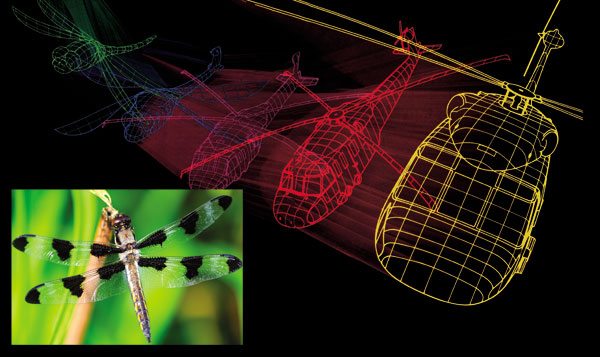
Sikorsky helicopters were designed in imitation of the flawless design and manoeuvr ability of a dragonfly.
In contrast, the flight system of these so-called "primitive insects" is nothing less than a wonder of design. The world's leading helicopter manufacturer, Sikorsky, finished the design of one of their helicopters by taking the dragonfly as a model.6 IBM, which assisted Sikorsky in this project, started by putting a model of a dragonfly in a computer (IBM 3081). Two thousand special renderings were done on computer in the light of the manoeuvres of the dragonfly in air. Therefore, Sikorsky's model for transporting personnel and artillery was built upon examples derived from dragonflies.
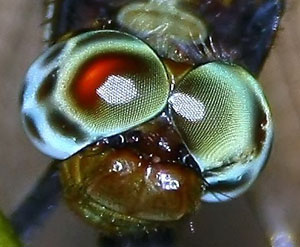
The eye of a dragonfly is considered the world's most complicated insect eye structure. Each eye contains about thirty thousand lenses. These eyes occupy about half the area of the head and provide the insect with a very wide visual field because of which it can almost keep an eye on its back. The wings of a dragonfly are of such a complex design that they make any conception of coincidence's involvement in their origin nonsense. The aerodynamic membrane of the wings and each pore on the membrane is a direct result of plan and calculation.
Gilles Martin, a nature photographer, has done a two year study examining dragonflies, and he also concluded that these creatures have an extremely complex flight mechanism.
The body of a dragonfly looks like a helical structure wrapped with metal. Two wings are cross-placed on a body that displays a colour gradation from ice blue to maroon. Because of this structure, the dragonfly is equipped with superb manoeuvrability. No matter at what speed or direction it is already moving, it can immediately stop and start flying in the opposite direction. Alternatively, it can remain suspended in air for the purpose of hunting. At that position, it can move quite swiftly towards its prey. It can accelerate up to a speed that is quite surprising for an insect: 25mph (40km/h), which would be identical to an athlete running 100 metres in the Olympics at 24.4mph (39km/h).
At this speed, it collides with its prey. The shock of the impact is quite strong. However, the armoury of the dragonfly is both very resistant and very flexible. The flexible structure of its body absorbs the impact of collision. However, the same cannot be said for its prey. The dragonfly's prey would pass out or even be killed by the impact.
Following the collision, the rear legs of dragonfly take on the role of its most lethal weapons. The legs stretch forward and capture the shocked prey, which is then swiftly dismembered and consumed by powerful jaws.
The sight of the dragonfly is as impressive as is its ability to perform sudden manoeuvres at high speed. The eye of the dragonfly is accepted as the best example among all the insects. It has a pair of eyes, each of which features approximately thirty thousand different lenses. Two semi-spherical eyes, each nearly half the size of the head, provide the insect a very wide visual field. Because of these eyes, the dragonfly can almost keep an eye on its back.
Therefore, the dragonfly is an assemblage of systems, each of which has a unique and perfect structure. Any malfunction in any one of these systems would derail the other systems as well. However, all of these systems are created without flaw and, hence, the creature lives on.

The figure above shows the wing movement of a dragonfly during flight. The front wings are marked with red dots. A close examination reveals that the front and back pairs of wings are flapped to a different rhythm, which gives the insect a superb flight technique. The motion of the wings is made possible by special muscles operating in harmony.
The most significant feature of the dragonfly is its wings. However, it is not possible through a model of progressive evolution to explain the flight mechanism that enables the use of the wings. First, the theory of evolution is at a loss on the subject of the origin of wings because they could only function if they developed altogether at once, in order to operate correctly.

A 250 million-year-old fossil dragonfly and a modern dragonfly
Let us assume, for a moment, that the genes of an insect on land underwent a mutation and some parts of the skin tissue on the body showed an uncertain change. It would be quite beyond reason to suggest that another mutation on top of this change could "coincidentally" add up to a wing. Furthermore, neither would the mutations to the body provide a whole wing to the insect nor would it do any good but decrease its mobility. The insect, then, needs to carry extra load, which does not serve any real purpose. This would put the insect at a disadvantage against rivals. Moreover, according to the fundamental principle of the theory of evolution, natural selection would have made this handicapped insect and its descendants extinct.
Mutations, moreover, occur very seldom. They always harm the creatures, leading to deadly sicknesses in most cases. This is why it is impossible for small mutations to cause some formations on the body of a dragonfly to evolve into a flight mechanism. After all this, let us ask ourselves: even if we assume, against all odds, that the scenario suggested by evolutionists might have been real, why is it that the "primitive dragonfly" fossils which would give substance to this scenario do not exist?
There is no difference between the oldest dragonfly fossils and the dragonflies of today. There is no remains of "a half-dragonfly" or a "dragonfly with newly emerging wings" that predates these oldest fossils.
Just as the rest of the life forms, the dragonfly, too, appeared all at once and has not changed to this day. In other words, it was created by Allah and never "evolved".
The skeletons of insects are formed by a tough, protective substance, called chitin. This substance was created with enough strength to form the exoskeleton. It is also flexible enough to be moved by the muscles used for flight. The wings can move back and forth or up and down. This motion of wings is facilitated by a complex joint structure. The dragonfly has two pairs of wings, one in a forward position with respect to the other. The wings operate asynchronously. That is, while the two frontal wings ascend, the back pair of wings descend. Two opposing muscle groups move the wings. The muscles are tied to levers inside the body. While one group of muscles pull up a pair of wings by contracting, the other muscle group opens the other pair by reflexing. Helicopters ascend and descend by a similar technique. This allows a dragonfly to hover, go backward, or quickly change direction.
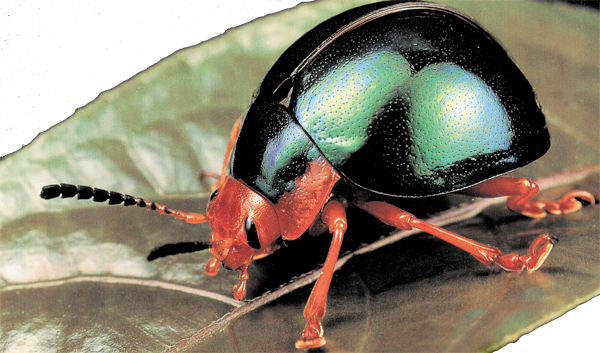
The chitin substance surrounding the body of insects is strong enough to act as a skeleton, which in this insect, is formed into a very eye-catching colour.
Female dragonflies do not mate again after fertilisation. However, this does not create any problem for the males of the Calopteryx Virgo species. By using the hooks on its tail, the male captures the female by the neck (1). The female wraps her legs around the tail of the male. The male, by using special extensions on its tail (2), cleans any possible sperm left from another male. Then, he injects his sperm into the female's reproductive cavity. Since this process takes hours, they sometimes fly in this clenched position. The dragonfly leaves the mature eggs in the shallows of a lake or a pool (3). Once the nymph hatches from the egg, it lives in water for three to four years (4). During this time, it also feeds in water (5). For this reason, it was created with a body capable of swimming fast enough to catch a fish and jaws powerful enough to dismember a prey. As the nymph grows, the skin wrapping its body tightens. It sheds this skin at four different times. When it is time for the final change, it leaves the water and starts climbing a tall plant or a rock (6). It climbs until its legs give in. Then, it secures itself by help of clamps at the tips of its feet. One slip and a fall means death at that point.

This last phase differs from the previous four in that Allah moulds the nymph into a flying creature through a wonderful transformation.
The back of the nymph cracks first (7). The crack widens and becomes an open slot through which a new creature, totally different from the preceding, struggles to get out. This extremely fragile body is secured with ties that stretch from the previous creature (8). These ties are created to have ideal transparency and flexibility. Otherwise they would break and not be able to carry it, which could mean that the larva could fall into the water and perish.
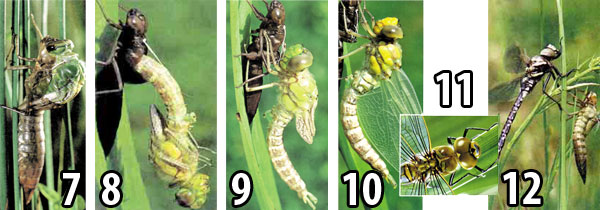
In addition, there are a series of special mechanisms that help the dragonfly to shed its skin. The body of the dragonfly shrinks and becomes wrinkled in the old body. In order to "open" this body, a special pump system and a special body fluid are created to be used in this process. These wrinkled body parts of the insect are inflated by pumping body fluid after getting out through the slot (9). In the meantime, chemical solvents start to break the ties of the new legs with the old ones without damage. This process takes place perfectly even though it would be devastating if only one of the legs were stuck. The legs are left to dry and harden for about twenty minutes before any testing.
The wings are fully developed already but are in a folded position. The body fluid is pumped by firm contractions of the body into the wing tissues (10). The wings are left drying after stretching (11).
After it leaves the old body and dries out completely, the dragonfly tests all the legs and wings. The legs are folded and stretched one by one and wings are raised and lowered.
Finally, the insect attains the form designed for flight. It is very hard for anyone to believe that this perfectly flying creature is the same as the caterpillar-like creature that left the water (12). The dragonfly pumps the excess fluids out, to balance the system. The metamorphosis is complete and the insect is ready to fly.
One faces the impossibility of the claims of evolution again when one tries by reasoning to find the origin of this miraculous transformation. The theory of evolution claims that all creatures came about through random changes. However, the metamorphosis of the dragonfly is an extremely intricate process that leaves no room for even a small error in any phase. The slightest obstacle in any one of these phases would cause metamorphosis to be incomplete resulting in the injury or death of dragonfly. Metamorphosis is truly an "irreducibly complex" cycle and therefore is an explicit proof of design.
In short, the metamorphosis of dragonfly is one of the countless evidences of how flawlessly Allah creates living things. The wonderful art of Allah manifests itself even in an insect.
|
A 1. Wings down 2. Wings up 3. Muscles relax from front to back B 4 .Muscles relax lengthways 5. Joint mechanisms 6.Main muscles lift the wings 7.Main muscles lower the wings
The double balance wing system is found to function in insects with less frequent flapping. | 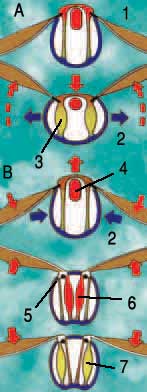 |
The wings of flies are vibrated according to the electric signals conducted by the nerves. For example, in a grasshopper each one of these nerve signals results in one contraction of the muscle that in turn moves the wing. Two opposing muscle groups, known as "lifters" and "sinkers", enable the wings to move up and down by pulling in opposite directions.
Grasshoppers flap their wings twelve to fifteen times a second but smaller insects need a higher rate in order to fly. For instance, while honeybees, wasps and flies flap their wings 200 to 400 times per second this rate goes up to 1000 in sandflies and some 1mm long parasites.7 Another explicit evidence of perfect creation is a 1mm long flying creature that can flap its wings at the extraordinary rate of one thousand times a second without burning, tearing or wearing out the insect.
When we examine these flying creatures a little closer, our appreciation for their design multiplies.
It was mentioned that their wings are activated by means of electrical signals conducted through the nerves. However, a nerve cell is only capable of transmitting a maximum of 200 signals per second. Then, how is it possible for the little flying insects to achieve 1000 wing flaps per second?
The flies that flap wings 200 times per second have a nerve-muscle relationship that is different from that of grasshoppers. There is one signal conducted for each ten wing flaps. In addition, the muscles known as fibrous muscles work in a way different from the grasshopper's muscles. The nerve signals only alert the muscles in preparation for the flight and, when they reach a certain level of tension, they relax by themselves.
There is a system in flies, honeybees, and wasps that transforms wing flaps into "automatic" movements. The muscles that enable flight in these insects are not directly tied to the bones of the body. The wings are attached to the chest with a joint that functions like a pivot. The muscles that move the wings are connected at the bottom and top surfaces of the chest. When these muscles contract, the chest moves in the opposite direction, which, in turn, creates a downward pull.
Relaxing a group of muscles automatically results in contraction of an opposite group followed by relaxation. In other words, this is an "automatic system". This way, muscle movements continue without interruption until an opposite alert signal is delivered through the nerves that control the system.8
A flight mechanism of this sort could be compared to a clock that works on the basis of a wound spring. The parts are so strategically located that a single move easily sets the wings in motion. It is impossible not to see the flawless design in this example. The perfect creation of Allah is evident.
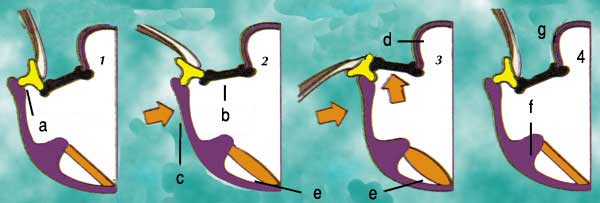
| 1 2 | 3 4 |
Some flies flap their wings up to a thousand times per second. In order to facilitate this extraordinary movement, a very special system was created. Rather than directly moving the wings, the muscles activate a special tissue to which the wings are attached by a pivot-like joint. This special tissue enables the wings to flap numerous times with a single stroke.

Encarsia
It is not enough to flap wings up and down in order to maintain smooth flight. The wings have to change angles during each flap to create a force of thrust as well as an up-lift. The wings have a certain flexibility for rotation depending on the type of insect. The main flight muscles, which also produce the necessary energy for flight, provide this flexibility.
For instance, in ascending higher, these muscles between wing joints contract further to increase the wing angle. Examinations conducted utilising high-speed film techniques revealed that the wings followed an elliptical path while in flight. In other words, the fly does not only move its wings up and down but it moves them in a circular motion as in rowing a boat on water. This motion is made possible by the main muscles.
The greatest problem encountered by insect species with small bodies is inertia reaching significant levels. Air behaves as if stuck to the wings of these little insects and reduces wing efficiency greatly.
Therefore, some insects, the wing size of which does not exceed one mm, have to flap their wings 1000 times per second in order to overcome inertia.
Researchers think that even this speed alone is not enough to lift the insect and that they make use of other systems as well.

Dust flies require large amounts of energy in order to maintain 1000 flaps per second. This energy is found in the carbohydrate-rich nutrients they gather from flowers. Because of their yellow and black stripes and their resemblance to bees, these flies manage to avoid the attention of many attackers.
As an example, some types of small parasites, Encarsia, make use of a method called "clap and peel". In this method, the wings are clapped together at the top of the stroke and then peeled off. The front edges of the wings, where a hard vein is located, separate first, allowing airflow into the pressurised area in between. This flow creates a vortex helping the up-lift force of the wings clapping.9

| 1. Revolving Disc | 6. Lines Representing Aircraft's Wings |
A fly is 100 billion times smaller than an aircraft. Nevertheless, it is equipped with a complex device functioning just like a gyroscope and a horizontal leveller, which are vitally important for flying. Its manoeuvrability and flight techniques, on the other hand, are far superior to those of the plane.
There is another special system created for insects to maintain a steady position in the air. Some flies have only a pair of wings and round shaped organs on the back called halteres. The halteres beat like a normal wing during flight but do not produce any lift like wings do. The halteres move as the flight direction changes, and prevent the insect from losing its direction. This system resembles the gyroscope used for navigation in today's aircraft.10

2. Tertiary Auxiliary Piece of Chitin
3. Folding Position
Many insects can fold their wings. When folded, the wings are easily manoeuvred by the help of auxiliary parts on their tips. The U.S. Air Force has produced E6B Intruder aircraft with folding wings after being inspired by this example. While bees and flies are able to fold their entire wings onto themselves, the E6B can only fold one half of its wing over the other.
The wing joint is comprised of a special protein, called resilin, which has tremendous flexibility. In laboratories, chemical engineers are working to reproduce this chemical, which demonstrates properties far superior to natural or artificial rubber. Resilin is a substance capable of absorbing the force applied to it as well as releasing the entire energy back once that force is lifted. From this point of view, the efficiency of resilin reaches the very high value of 96%. This way, approximately 85% of the energy used to lift the wing is stored and reused while lowering it.11 The chest walls and muscles are also built to help this phenomenon.

Right: The figure, which indicates the route travelled by a bee placed inside a glass cube, shows how successful the bee is in flying in any direction including upward and downward, in landings and take offs.
Left:The figure on left shows the manoeuvring capability of three aircraft that are considered the best in their categories. However, flies and bees are able to suddenly change course in any direction without reducing speed. This example clearly demonstrates how weak the technology of jet planes is in comparison with bees and flies.

| 1. Epithelial Cell | 4. Trachea |
There is an extraordinary system created in the bodies of flies and other insects in order to meet the need for a high oxygen supply: Air, just as in blood circulation, is carried directly into tissues by means of special tubes. Above is an example of this system in grasshoppers:
A) The windpipe of a grasshopper pictured by an electron microscope. Around the walls of the pipe, there is spiral reinforcement similar to that of the vacuum cleaner hose.
B) Each windpipe tube delivers oxygen to the cells of the insect's body and removes carbon dioxide.
Flies fly at extremely high speeds when compared to their size. Dragonflies can travel as fast as 25 mph (40 km/h). Even smaller insects can reach up to 31 mph (50km/h). These speeds are equivalent to humans travelling at the speed of thousands of miles per hour. Humans can only reach these speeds using jet planes. However, when one considers the size of jet planes in comparison to the size of humans it becomes clear that these flies actually fly faster than aeroplanes.
Jets use very special fuels to power their high-speed engines. The flight of flies, too, requires high levels of energy. There is also a need for large volumes of oxygen in order to burn this energy. The need for great amounts of oxygen is satisfied by an extraordinary respiratory system lodged within the bodies of flies and other insects.
This respiratory system works quite differently from ours. We take air into our lungs. Here, oxygen mixes with the blood and then is carried on to all parts of the body by the blood. The fly's need of oxygen is so high that there is no time to wait for the oxygen to be delivered to the body cells by the blood. To deal with this problem, there is a very special system. The air tubes in the insect's body carry the air to different parts of the fly's body. Just like the circulatory system in the body, there is an intricate and complex network of tubes (called the tracheal system) that delivers oxygen-containing air to every cell of the body.
Thanks to this system, the cells that make up the flight muscles take oxygen directly from these tubes. This system also helps to cool down the muscles which function at such high rates as 1000 cycles per second.
It is evident that this system is an example of creation. No coincidental process can explain an intricate design. It is also impossible for this system to have developed in phases as suggested by evolution. Unless the tracheal system is fully functional, no intermediate stage could be to the advantage of the creature, but on the contrary, would harm it by rendering its respiratory system non-functional.
All of the systems that we have explored so far uniformly demonstrate that there is an extraordinary design to even the least significant of creatures such as flies. Any single fly is a miracle that testifies to the flawless design in the creation of Allah. On the other hand, the "evolutionary process" espoused by Darwinism is far from explaining how a single system in a fly develops.
In the Qur'an, Allah invites all humans to consider this fact:
Mankind! An example has been made, so listen to it carefully. Those whom you call upon besides Allah are not even able to create a single fly, even if they were to join together to do it. And if a fly steals something from them, they cannot get it back. How feeble are both the seeker and the sought! (Surat al-Hajj: 73)
Even a single fly is superior to all the technological devices that mankind has produced. Furthermore, it is a "living being". Aircraft and helicopters are of use for an appointed time after which they are left to rust. The fly, on the other hand, produces similar offspring.
 |
"Mankind! An example has been made, so listen to it carefully.
Those whom you call upon besides Allah are not even able to
create a single fly, even if they were to join together to do it...
They do not measure Allah with His true measure.
Allah is All-Strong, Almighty."
(Surat al-Hajj: 73-74)
 |
| The housefly uses the labellum in its mouthpart to "quality test" food before feeding. Unlike many creatures, flies digest their food externally. It applies a solvent fluid to the food. This fluid dissolves the food into a liquid that the fly can suck. Then, the fly takes the liquid nutrients into itself by means of the labella which gently dabs liquids into its proboscis.38 A fly can easily walk on the most slippery surfaces or stand still on a ceiling for hours. Its feet are better equipped to hold on to glass, walls and ceilings than those of a climber. If the retractable claws are not enough, suction pads on its feet attach it to the surface. The holding strength of the suction has been increased with a specially applied fluid. |
The flight of a housefly is an extremely complex phenomenon. First, the fly meticulously inspects the organs to be used in navigation. Then, it takes position ready for flight by adjusting the balancing organs in front. Lastly, it calculates the angle of take-off, dependent on wind direction and velocity, by means of the sensors on its antennae. Then it takes flight. But, all of these happen within one hundredth of a second. Once airborne, it can accelerate rapidly and reach a speed of 6 mph (10 km/h).
For this reason, we could well use the nickname "master of acrobatic flight" for it. It can fly in extraordinary zigzags through the air. It can take off vertically from where it stands. No matter how slippery or uninviting the surface, it can land successfully anywhere.
Another feature of this magical master of flight is its ability to land on ceilings. Because of gravity it shouldn't hold on but fall down. However, it has been created with certain systems to render the impossible possible. At the tip of its legs, there are minute suction pads. In addition, these pads exude a sticky fluid when in touch with a surface. This sticky fluid enables it to remain attached to a ceiling. While approaching ceiling, it stretches its legs forward and as soon as it senses the touch of a ceiling it flips around and takes hold of the ceiling's surface. The housefly has two wings. These wings, that are halfway merged in the body and are comprised of a very thin membrane intersected by veins, can be operated independently from one another. However, while in flight they move back and forth on one axis just as in single-winged planes. The muscles enabling movement of the wings contract at take-off and relax on landing. Although controlled by nerves at the beginning of flight, these muscles and wing movements become automatic after a while.
Sensors under the wings and on the back of its head send information about the flight immediately to its brain. If the fly encounters a new airflow during flight, these sensors promptly send the necessary signals to the brain. The muscles, then, start to direct the wings according to the new situation. That is how a fly can detect another insect creating extra airflow and can escape to safety most of the time. The housefly moves its wings hundreds of times a second. The energy spent during flight is roughly a hundred times that spent during rest. From this point of view, we can say that it is a very powerful creature because human metabolism can only spend ten times as much energy in emergency situations in comparison to during the normal tempo of life. In addition, a human can maintain this energy expenditure for a maximum of only a few minutes. In contrast, the housefly can sustain that rhythm for up to half an hour and it can travel up to a mile at the same speed.12
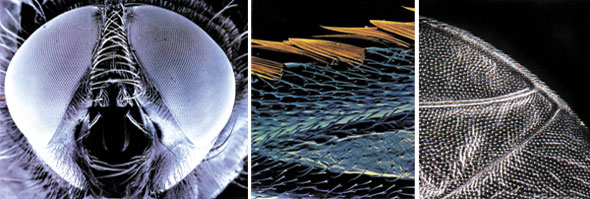 |
|---|
| The housefly's eye is composed of 6000 hexagonally arranged eye structures, called ommatidia. Since each ommatidium is directed in different directions, e.g. forwards, backwards, beneath, above and on all sides, the fly can see everywhere. In other words, it can sense everything within a 360-degree visual field. Eight photo receptors (light-receiving) neurons are attached to each one of these units therefore the total number of sensor cells in an eye is about 48,000. This is how it can process up to one hundred images per second. The design of its wings gives a fly its superior flying skills. The edges, surfaces and veins of these wings are covered with highly sensitive sensory hairs which enable the fly to detect airflow and mechanical pressures. |
4. Robin J. Wootton, "The Mechanical Design of Insect Wings", Scientific American, Volume 263, November 1990, Page 120.
5. Pierre Paul Grassé, Evolution of Living Organisms, New York, Academic Press, 1977, P.30
6. "Exploring The Evolution of Vertical Flight At The Speed of Light", Discover, October 1984, Pp. 44-45.
7. Ali Demirsoy, Yasamin Temel Kurallari (Basic Fundamentals of Life), Ankara, Meteksan As., Volume Ii, Section Ii, 1992, P. 737.
8. Bilim Ve Teknik Görsel Bilim Ve Teknik Ansiklopedisi (Encyclopedia of Science and Technology), Istanbul, Görsel Publications, P. 2676.
9. Bilim Ve Teknik Görsel Bilim Ve Teknik Ansiklopedisi (Encyclopedia of Science and Technology) P. 2679.
10. Smith Atkinson, Insects, London, Research Press, Volume I, 1989, P. 246.
11. Bilim Ve Teknik Görsel Bilim Ve Teknik Ansiklopedisi (Encyclopedia of Science and Technology), P. 2678.
12. Dieter Schweiger, "Die Fliegen", Geo, April 1993, Pp. 66-82.